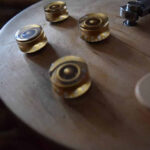For enthusiasts of Hawaiian guitars and vintage instruments, the thrill of discovery can strike in unexpected places. Recently, a unique find at Guitar Center turned a casual browse into a remarkable story of guitar history and preservation. This is the tale of how a seemingly unassuming instrument, encountered amidst the racks of guitars at Guitar Center, was revealed to be a rare, late-era Knutsen Hawaiian guitar, crafted by the esteemed Chris J. Knutsen.
The journey began with a persistent intuition. After passing by the same guitar at Guitar Center for three years, a feeling sparked that this was more than just an old Hawaiian guitar. It was a hunch that resonated with the distinctive craftsmanship of Chris J. Knutsen, a pioneer whose Hawaiian guitars predated and influenced the renowned Weissenborn instruments. In fact, Knutsen is believed to have played a significant role in Weissenborn’s foray into crafting Hawaiian guitars.
Driven by this intuition, a closer inspection was warranted. A visit to Guitar Center, armed with a camera, turned suspicion into informed curiosity. Sharing images with Gregg Miner of The Knutsen Archives confirmed the likely origins of the instrument. Negotiations with Guitar Center followed, and the guitar is now en route to Gregg Miner’s expert hands. While personal acquisition and restoration weren’t feasible at the time, the satisfaction lies in knowing this piece of guitar history will be lovingly restored and played. There was even the privilege of briefly playing melodies like “Akaka Falls” on this soon-to-be-restored treasure within Guitar Center’s walls.
This particular Knutsen Hawaiian guitar holds further intrigue in its construction. Originally conceived as a left-handed harp Hawaiian guitar, it was ingeniously converted by Chris Knutsen into a right-handed, six-string instrument during its creation. Evidence of its initial design remains visible, with the “stars” on the bass-side pickguard marking where treble harp strings would have been anchored. The bridge and neck also bear the hallmarks of a design intended to accommodate bass harp strings, showcasing Knutsen’s evolving craftsmanship.
An internal examination reveals a blend of original, idiosyncratic lutherie and subsequent repairs, a testament to the guitar’s age and journey. Perhaps the most curious internal detail is the presence of church service bulletins adhered to the top – an undoubtedly later, and somewhat unconventional, modification. While Guitar Center’s tag estimated the guitar’s age as “1930s,” closer examination suggests a more precise dating to the 1927-1930 period.
To delve deeper into the captivating world of these instruments, resources like The Knutsen Archives and publications such as “Chris J. Knutsen: From Harp Guitars to the New Hawaiian Family: History and Development of the Hawaiian Steel Guitar” offer invaluable insights. For an auditory experience, seek out Bob Brozman’s performances on Tone Poems III, featuring the distinctive voice of a Knutsen guitar.

